On August 10, the Senate passed the Infrastructure Investment and Jobs Act (PDF) by a vote of 69-30. Much of the attention was on the bill’s eye-popping $550 billion in new spending, the Congressional Budget Office’s estimate that it will add $256 billion to federal deficits over the next decade, and the massive 2,739 pages of bill text. Despite the breadth and depth of the legislation, one transportation policy subject was largely ignored: automated vehicles (AVs). The absence of language about automated vehicles in the bill is the latest in a string of policy disappointments for automated vehicle developers and weakens the U.S. position in the increasingly competitive global AV marketplace.
The bill does make minor new automated vehicles-related authorizations for programs administered by the U.S. Department of Transportation:
- Section 11135 – Updates to Manual on Uniform Traffic Control Devices: This section directs the U.S. Department of Transportation to update the Manual on Uniform Traffic Control Devices to provide for “supporting the safe testing of automated vehicle technology and any preparation necessary for the safe integration of automated vehicles onto public streets.” (.pdf, p. 219)
- Section 13005 – Emerging Technology Research Pilot Program: This section creates a new grant program at $5 million per year for five years, where authorized activities eligible for funding include research “regarding the impacts of connected, autonomous, and platooned vehicles on pavement and infrastructure performance.” (.pdf, p. 524)
- Section 13006(c) – Research and Technology Development and Deployment: This section creates a new Center of Excellence on New Mobility and Automated Vehicles to coordinate research on the “impacts of new mobility and highly automated vehicles” and orders a report to Congress on research progress due one year after enactment. (.pdf, p. 545)
- Section 25005 – Strengthening Mobility And Revolutionizing Transportation Grant Program: This section creates a new grant program (“SMART”) at $100 million per year for five years, where authorized activities eligible for funding include “[t]he use of automated transportation and autonomous vehicles, while working to minimize the impact on the accessibility of any other user group or mode of travel.” (.pdf, p. 1080)
In addition, the Senate’s infrastructure bill includes appropriations language for the National Highway Traffic Safety Administration (NHTSA), under Division J, Title VIII, where the appropriation for the agency’s Vehicle Safety and Behavioral Research Programs explicitly includes mention of “behavioral research on Automated Systems and Advanced Driver Assistance Systems” as being eligible for research funding. (.pdf, p. 2647)
However, on the key issues facing automated vehicle developers—namely, existing policy barriers to deployment—the bill is silent. This is unfortunate, given that Congress demonstrated several years ago that it is acutely aware of these issues.
The most significant federal policy barrier faced by automated vehicle developers—and specifically those developing highly automated vehicles equipped with automated driving systems that are commonly referred to as “self-driving”—is NHTSA’s Federal Motor Vehicle Safety Standard (FMVSS) self-certification process. FMVSS are regulations that dictate minimum safety and performance requirements for new domestically manufactured and imported motor vehicles, of which there are currently 73. NHTSA’s experience with past rulemakings suggests AV-related FMVSS modernization may take years even after relevant voluntary consensus technical standards are published and ripe for regulatory incorporation. AV developers wishing to bring their technologies to market prior to the promulgation of new or amended safety regulations will likely need to seek temporary FMVSS exemptions.
Under current law, FMVSS exemptions limit developers of AVs with noncompliant novel designs to 2,500 vehicles per year for two years, with an opportunity to renew the exemption for another two years. For comparison, established parcel carriers operate hundreds of thousands of delivery vehicles, and ride-hailing firms have more than a million drivers in the U.S. A September 2020 report (.pdf) commissioned by AV startup Nuro estimates that a quarter-million to two million automated delivery vehicles will be needed to meet U.S. customer demand by 2030. Ten thousand exempt vehicles over four years per manufacturer are not nearly enough to allow future providers of AV services such as taxis and last-mile delivery to scale nationwide.
Both the SELF DRIVE and AV START Acts considered during the 115th Congress in 2017 and 2018 would have substantially increased the annual FMVSS exemption cap for automated vehicles from 2,500 to 100,000 in the former and 80,000 in the latter. Both would have also increased the length of the exemption period from two years to four years, with the potential for renewing the exemption for an additional four years. And both would have maintained existing requirements for manufacturers to demonstrate to NHTSA that their noncompliant vehicles offer an equivalent level of safety or better in order to be granted an FMVSS exemption. Unfortunately, while the SELF DRIVE Act passed the House by unanimous voice vote, the AV START Act stalled in the Senate due, in part, to shifting demands from lobbyists representing a variety of interests, including trial lawyers and purported consumer advocates. Since then, numerous attempts to revive this bipartisan legislation have failed.
With the failure to include substantive AV legislation in the Senate-passed infrastructure bill, which includes a five-year surface transportation reauthorization, it is unclear when or even if Congress will address AV-related FMVSS exemptions. A multiyear surface transportation reauthorization that contains a highway safety title that is the most likely venue to address AV matters, especially given the failure of standalone AV legislation in recent years. As a February 2021 report (.pdf) from the law firm Dentons highlighted, governments of peer countries appear increasingly determined to demonstrate to automated vehicle developers that they offer more hospitable regulatory environments than the United States.
Congress should act quickly to pass narrowly tailored automated vehicles legislation to ensure U.S.-based AV developers are not at a disadvantage in the increasingly competitive global AV marketplace.
For more discussion and recommendations on modernizing U.S motor vehicle policy for the AV age, see Reason Foundation’s recent reports on federal and state automated vehicles policy.

